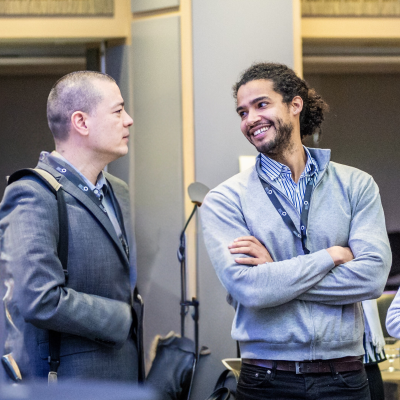TME dynamics
This is a new challenge, which we announced in March 2025. It is open for Expressions of Interest, with the successful team(s) being awarded up to £20m ($25m) to tackle it. Submissions are due by 18 June 2025.Challenge: Develop methods to identify the functional role of the tumour microenvironment over time.
This is one of seven new challenges.
Want to take on this challenge? We are now calling on the global research community to assemble teams and submit an Expression of Interest.
Currently viewing section: Context
Context
Advances in spatial transcriptomics and proteomics have significantly advanced the characterisation of the cellular composition and heterogeneity of tumour lesions. Despite these advances, major gaps remain in understanding the functional interactions that drive organisation and the formation of microanatomical niches of the tumour microenvironment (TME), how the TME evolves over time and during exposure to therapies, and how specific TME organisation promotes tumour growth or resistance to current therapies.
Standard biopsy and histology approaches provide static snapshots, failing to capture the diverse but spatially restricted and evolving cell populations that may drive therapeutic resistance. Moreover, the TME continuously evolves, responding to tumour cues, cellular interactions, immune pressures, metabolic changes and therapeutic interventions.
This challenge goes beyond mapping the TME and aims to develop new methods to interrogate over time and at a functional level, interactions between the cellular, stromal, and non-cellular components of the TME to understand cancer development, progression and response to therapy.
Barriers and opportunities
A major opportunity lies in obtaining longitudinal data on TME formation and evolution in patients, generating hypotheses that can be tested in preclinical models using dynamic functional spatial genomics and other approaches.
Interdisciplinary teams will be required to overcome barriers such as the need for novel sampling technologies that capture the full heterogeneity of the TME while preserving spatial integrity. Teams may also need to develop new tools to investigate functional inter-cellular interactions, incorporating AI and computational modelling to simulate and test hypotheses of which cellular interactions may drive cancer progression and therapeutic response or resistance.
Note: Applications focused on a subset of cell types in the TME, cross-sectional measurements of spatial organisation in the TME, studies only in animal models without guidance from human analyses, pure ‘mapping’ exercises, or studies lacking functional and longitudinal components will not be considered responsive to the challenge.
Vision and impact
This challenge will enable the dynamic functional profiling of the TME, elucidating the drivers of TME organisation and evolution, and the functional role of the TME in cancer development, progression and response to treatment.
Understanding how these interactions dynamically shift over time and in response to therapy will inform next-generation treatment strategies that prevent resistance and enhance patient outcomes, ultimately reshaping cancer treatment and improving long-term survival.
Plain language summary: why TME dynamics?
A tumour does not grow in isolation; it is surrounded by a complex supportive network of cells, blood vessels, and immune signals known as the tumour microenvironment (TME). This environment plays a key role in how cancer develops, spreads, and responds to treatment. Scientists have made significant progress in mapping the different cells within a tumour at a single point in time, but cancer is constantly changing. Understanding how the TME changes over time, and how it helps tumours resist treatment, is a major challenge in cancer research.
This Cancer Grand Challenge aims to develop new ways to track and study the TME in real-time. These methods could reveal how interactions between cancer cells and the TME influence cancer progression and treatment response. By identifying which parts of the TME help cancer grow or make it resistant to therapy, researchers could design new strategies to stop tumours from adapting to treatment. If successful, this research could lead to new therapies that prevent resistance from happening, improving long-term survival for cancer patients.
Submit your Expression of Interest
Support the next scientific breakthrough
If you're interested in joining our international network of partners and donors and funding our next round of teams, please get in touch.

